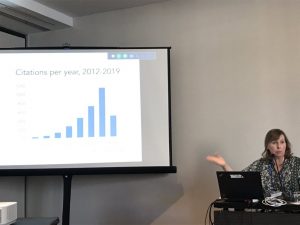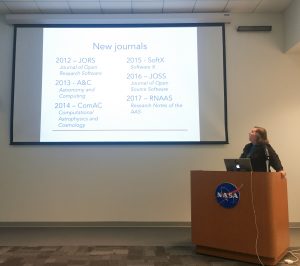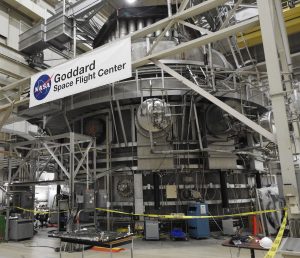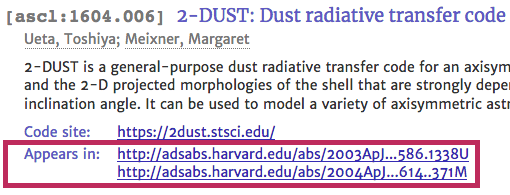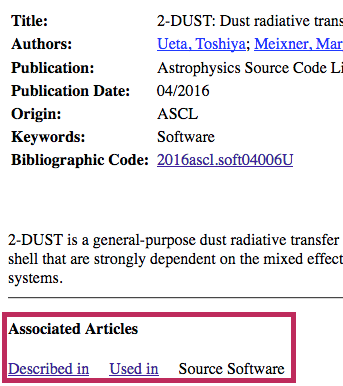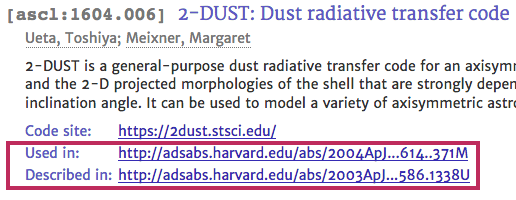This post was written by Brian Thomas, Alice Allen, Marc W. Pound, and Peter Teuben, and, with part 2, will appear in the ADASS XXVIII proceedings.
Brian is with the Office of Chief Information Officer, NASA HQ, Washington DC; Marc, Peter, and Alice are in the Astronomy Department at the University of Maryland in College Park, MD.
In this post, we describe the ADASS XXVIII hackathon, the first associated with an ADASS conference, and provide our motivation and the details of the event. A subsequent post discusses the lessons we learned from holding this event and our conclusions about it.
Introduction
A hackathon seeks to draw together a large group of folks for an intense and extended period of creative programming. Hackathons may be held for a variety of purposes including, but not limited to, teaching (Huppenkothen et al. 2018), to draw together a technical community as a social event (Kellogg et al. 2019), and to draw attention to solving particular challenges or themes (as found, for example, on popular sites such as Kaggle). Pa Pa Pe Than et al. (2018) provides a broader overview of hackathon applications and uses.
Our motivation for holding a hackathon associated with the ADASS XXVIII meeting was aligned with outreach to interested individuals; we wanted to highlight topical technical problems that the ADASS community might be concerned with and introduce a new generation of rising computer programmers and scientists to the excitement of solving them. We chose the topic area of Time Domain Astronomy (TDA) to focus on for this event as it was also one of the themes for this year’s ADASS meeting and aligned well with the interests of the Department hosting the hackathon. We allowed a loose definition of TDA, dealing with any astronomical data where time was a parameter. Thus projects for this hackathon could involve, for example, variable stars, exoplanets, and bodies in the solar system.
Event Organization
The ADASS hackathon took place the weekend before the ADASS starting on Saturday morning and ending at noon on Sunday with the total event time being 27 hours. We provided a space in the University of Maryland Physical Sciences Complex (PSC) as well as snacks and coffee. The participants were required to attend the introduction and be present for final presentations at 11am on Sunday. Otherwise, they could stay in the PSC building or leave as they desired. A cash award (provided by the City of College Park) was available for the top 3 teams with $500, $350 and $150 being awarded to the first, second and third place teams respectively. The winning team was also provided time to present their hack during the ADASS meeting.
We began by having the participants introduce themselves, their backgrounds and interests. We then introduced the participants to the field of TDA, providing some general background and challenges in this area. Presentations were given by Charlotte Ward (UMD graduate student), Gerbs Bauer (UMD Research Professor), and Brian Thomas (NASA). We highlighted some datasets which could be applied to solving aspects of the challenges. This was followed by a freely flowing brainstorming session where people could discuss ideas and questions, and potential hacks could be focused. Ideas were placed on sticky notes on a wall. Participants were then allowed a short period of time to form teams and brainstorm. After another hour or so, each team presented an outline of their hack, potentially allowing members to join another team if skill sets were better suited elsewhere. In our case nobody decided to join another team.
We allowed for a range of project types. Projects could be new analyses or approaches or novel ways of understanding existing solutions or problems. The final product could be a proof-of-concept app, a plugin to existing code, a storyboard design, or really anything that embodies creative hacking around the TDA theme. We did not require that the final project be polished; a good idea that was well fleshed out could also be submitted. A final presentation of a few slides describing the work including the motivation and approach was the only requirement for consideration for a prize.
We used Devpost to help structure the hackathon. This site served as a centralized location from which information could be disseminated including rules of conduct and a discussion board which we used to distribute ideas and answer participant questions. Hackathon rules can be summarized as follows:
- Each participant belongs to one team and one final submission, but is allowed to switch teams. Team makeup is not final until the presentation. The maximum team size was 5.
- Only 1 submission per team.
- A Code of Conduct. We did not tolerate harassment of hackathon participants in any form, including, but not limited to, harassment based on gender identity and expression, age, sexual orientation, disability, physical appearance, body size, race, ethnicity, nationality, religion, political views, previous hackathon attendance, lack of computing experience, or chosen programming language or tech stack. Sexual language and imagery was not appropriate at any point in the hackathon including in software hacks, social media, talks, presentations, or demos.
Hackathon participants violating any of these rules could be sanctioned or expelled
from the hackathon at the discretion of the hackathon organizers.
Participants
Our event was set up as a community hackathon and attracted students, professional hackathonners, and ADASS participants who formed teams (see below). Members of the hosting department and the ADASS program organizing committee served as judges. Out of the 34 original registrations, 6 were present but not playing (being part of the organization or just cheerleading), and 9 did not show up.
Judges, Organizers, and Teams
The session was organized by Peter Teuben, Brian Thomas, Alice Allen, Marc Pound, and Elizabeth Warner. Our judges were Alice Allen, Gerbs Bauer, Andy Harris, Nuria Lorente, Ada Nebot, and Brian Thomas. The 7 teams that participated are listed in Table 1. We have also noted which teams won which prizes.
| Team members |
Project name |
| Sarah Frail and Patrick Shan |
Morpheus – Near Earth Objects Visualization |
| Marco Lam |
Drag and drop ensemble (2nd prize) |
| Paul Ross McWhirter and Josh Veitch-Michaelis |
Auto periodogram selection using MC (3rd prize) |
| Timothy Henderson and Matt Graber |
Solar Activity Viewer |
| Thomas Boch, Matthieu Baumann, and Siddha Mavuram |
Music of Light curves (1st prize) |
| Kyle Kaplan, Sankalp Gilda, Hayden Hotham, Steve Gambino, and Abbie Petulante |
ML on ZTF pipeline |
| Kevin Cai, Kael Lenus, James Zhou, and Justin Otor |
Fixed and Variable Time Kepler Viewer in WWT |
Table 1. Hackathon Teams
The winning team “The Music of Light Curves” made their hack, the sonification of variable stars from the Gaia catalogue, available on https://tboch.github.io/music-lightcurves-hack/. Their presentation to the ADASS audience during the TDA session on Wednesday met with resounding applause (and later a mention in the international press).
Continue to Part 2, Lessons Learned and Conclusions
